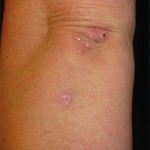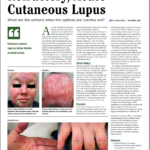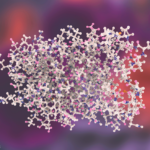Cutaneous dermatomyositis typically demonstrates a milder interface dermatitis than CLE, and a sizable number of patients may not show interface dermatitis at all. Perivascular dermatitis, spongiotic dermatitis or psoriasiform dermatitis are other potential findings on biopsy of dermatomyositis lesions. Certain myositis-specific antibodies track with particular skin findings, such as the psoriaform lesions seen in patients with antibodies to transcriptional intermediary factor 1 gamma or the ulcerative lesions seen in patients with antibodies to melanoma differentiation-associated gene 5.
Dr. Kang regards methotrexate, mycophenolate mofetil and azathioprine as first-line treatments for dermatomyositis, followed by IVIG, Janus kinase inhibitors, such as tofacitinib and ruxolitinib, rituximab and calcineurin inhibitors. Anti-malarials can be used, but 20–30% of patients with dermatomyositis may develop a hypersensitivity rash.
Neutrophilic Dermatoses
The final category of disease discussed was neutrophilic dermatoses, which are characterized by intense epidermal, dermal or hypodermal neutrophilic infiltration on histology; secondary or focal vasculitis can also be seen.
When evaluating a neutrophilic dermatosis, Dr. Kang implores clinicians to think of etiologies, such as malignancy, medications, infections and pregnancy in addition to autoimmune, autoinflammatory and genetic conditions. Sweet’s syndrome and pyoderma gangrenosum are classic examples of neutrophilic dermatoses.
A newer condition doctors must consider is VEXAS syndrome. A review noted that neutrophilic dermatitis is a common skin finding in VEXAS in addition to leukocytoclastic vasculitis and/or leukocytoclasia. The same loss-of-function UBA1 variant present in the bone marrow of patients with VEXAS has been identified in dermal infiltrates.5
All told, Dr. Kang’s lecture was wide ranging and useful to practicing rheumatologists. The key message was stressed a meticulous, thoughtful approach to each patient, which is necessary if clinicians are to pick up on the subtle clues of rheumatology that manifest in the skin.
Jason Liebowitz, MD, is an assistant professor of medicine in the Division of Rheumatology at Columbia University Vagelos College of Physicians and Surgeons, New York.
References
- Stein H, Lowenstein EJ. Occam’s razor and Hickam’s dictum: A dermatologic perspective. Diagnosis (Berl). 2022 Nov 18;10(2):96–99.
- Stull C, Sprow G, Werth VP. Cutaneous involvement in systemic lupus erythematosus: A review for the rheumatologist. J Rheumatol. 2023 Jan;50(1):27–35.
- Alsomali DY, Bakshi N, Kharfan-Dabaja M, El Fakih R, Aljurf M. Diagnosis and treatment of subcutaneous panniculitis-like T-cell lymphoma: A systematic literature review. Hematol Oncol Stem Cell Ther. 2023 Jan 17;16(2):110–116.
- Chasset F, Jaume L, Mathian A, et al. Rapid efficacy of anifrolumab in refractory cutaneous lupus erythematosus. J Am Acad Dermatol. 2023 Jul;89(1):171–173.
- Nicholson LT, Cowen EW, Beck D, Ferrada M, Madigan LM. VEXAS syndrome—diagnostic clues for the dermatologist and gaps in our current understanding: A narrative review. JID Innov. 2023 Oct 29;4(1):100242.



